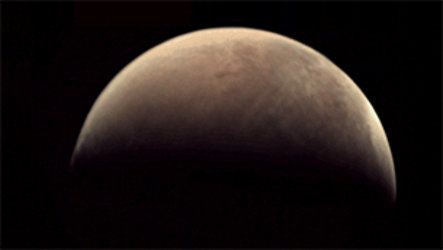Timeline: ESA spacecraft and station track critical arrival at Mars
Early on 6 August, Mars Express will receive crucial signals from NASA’s Mars Science Laboratory mission as it delivers the car-sized Curiosity rover onto the Red Planet.
The ESA spacecraft will begin tracking the NASA mission 45 minutes before it enters the martian atmosphere; an ESA ground station will also record vital signals.
The highlight of ESA’s support for NASA’s Curiosity landing happens at 06:29 on Monday, 6 August, when the Mars Express Lander Communication (MELACOM) system is switched on. Recording of the radio signals transmitted by the Mars Science Laboratory (MSL) is planned to begin at 07:09 and end at 07:37 (all times shown as ground event time in CEST).
ESA’s ground tracking station in New Norcia, Australia, will also listen and record signals from the NASA mission at the same time.
During arrival, MSL’s Curiosity rover, still attached to the Entry, Descent and Landing system, will enter Mars’ atmosphere at almost 21 000 km/h, and be slowed by a parachute and thrusters to just 3.6 km/h for a gentle touch down in Gale Crater.
Signals take nearly 14 minutes to reach Earth

“Upon completion of recording, Mars Express will store the digitally recorded radio signal on board in two separate memory locations, for redundancy, and then point its large, high-gain antenna at Earth to download the files,” says Michel Denis, Spacecraft Operations Manager at ESOC, ESA’s European Space Operations Centre.
At 08:15, Mars Express will contact Earth via ESA’s 35 m deep space station at New Norcia, and begin transmitting the recorded information, which should take about 11 minutes to download; signals will take nearly 14 minutes to cover the 248 million km distance to Earth.
Mars Express and New Norcia recordings sent to NASA
The transfer will be complete by about 08:26; the data will be transferred in real time to ESOC, and made immediately available to NASA’s MSL mission team at the Jet Propulsion Lab in California.
The signal recordings made by ESA’s New Norcia station will also be transferred to JPL upon receipt.

To ensure safe receipt of the signal recorded on board during this unique event, Mars Express will subsequently download it again via New Norcia and a third time via ESA’s 35 m station at Cebreros, Spain.
“A lot of hard work and close cooperation between ESA and NASA has gone into preparation for ESA’s support to Mars Science Lab,” says ESA’s Manfred Warhaut, Head of Mission Operations. “Mars Express and our teams are ready and we all are looking forward to a spectacular arrival on Mars. ”
Timeline

CEST = UTC + 2 hours
Earth time = Mars time + 13min:48sec
MEX: Mars Express
MSL: Mars Science Laboratory
NNO: ESA New Norcia station
AOS: Acquisition of signal
S/C: Spacecraft
All times subject to change
















 Germany
Germany
 Austria
Austria
 Belgium
Belgium
 Denmark
Denmark
 Spain
Spain
 Estonia
Estonia
 Finland
Finland
 France
France
 Greece
Greece
 Hungary
Hungary
 Ireland
Ireland
 Italy
Italy
 Luxembourg
Luxembourg
 Norway
Norway
 The Netherlands
The Netherlands
 Poland
Poland
 Portugal
Portugal
 Czechia
Czechia
 Romania
Romania
 United Kingdom
United Kingdom
 Slovenia
Slovenia
 Sweden
Sweden
 Switzerland
Switzerland





































